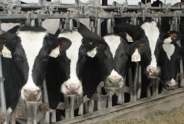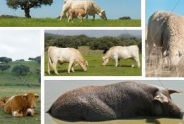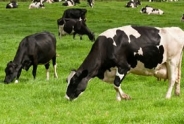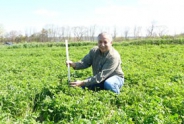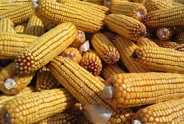The Slow and Furtive Nature of Pasture Soil Compaction: Project Develops Ratio..
A. Fay Benson, Small Dairy Extension Educator
South Central New York Dairy & Field Crops
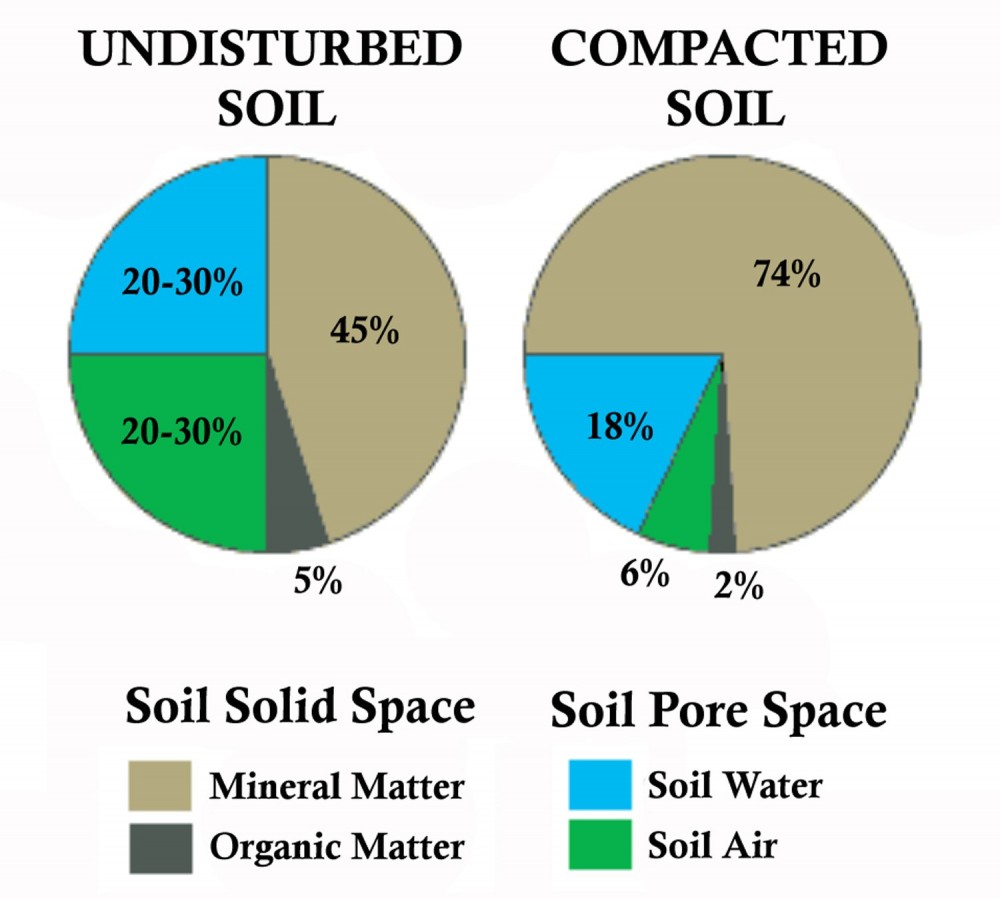
THE SLOW AND FURTIVE NATURE OF PASTURE SOIL COMPACTION: Project Develops Ratio to Monitor Impact
By Fay Benson, Cornell Cooperative Extension of Cortland County
In my work, first as a grazing dairy farmer and now as a Cornell University Cooperative Extension educator working with graziers across New York State, I have been aware of pasture soil compaction but one experience in particular gave me the insight into the slow and furtive nature of compaction in pastures. This article summarizes my findings from a three-year, Northeast Sustainable Agricultural Research and Extension (NESARE)-funded project developed to better understand soil compaction in pastures.
Permanent pastures for livestock can have some of the healthiest soils due to the fact they provide the four principles described by the Natural Resources Conservation Service to achieve a healthy soil: Maximize Soil Cover, Maximize Living Roots Year-round, Maximize Plant and Animal Diversity, and Minimize Soil Disturbance.
One weak spot for some pastures is soil compaction, which is a form of soil disturbance. Soil compaction reduces the spaces between soil particles causing them to become denser. Theoretically, the space in a healthy soil aggregate is made up of 25% air, 25% water, 45% of sand, silt, or clay, and 5% organic matter. When compacted, the soil's air and water portions are reduced so that biological functions, water retention, and root elongation are reduced.
Once the grazing season arrives, livestock go into the pastures no matter the weather, if the soil is wet its more prone to compaction. Whether the livestock is cows, horses, or small ruminants, the weight of the animal compared to the size of the hoof can exert more compaction than a tractor. This is why in the past; sheep were used to pack an area to create a dam. Even though the animal's compaction is great it only shows up in the upper portion of the soil where it can be erased in time provided that it's not repeated. Compaction from the tractor goes deeper into the soil where it is harder to erase. This is more damaging in terms of overall soil health.
Repeating compaction over many years causes a very slow and damaging effect on the functions of the soil and the species that make up your grazing sward, reducing the productivity of your pastures. What I learned from my three-study is that although compaction is unavoidable, a change in management will quickly remedy it.
How This Study Started As I was working on another SARE-funded study, planting brassicas into fall pastures to improve the nutrient density of the fall swards (https://projects.sare.org/project-reports/one14-197/, I noticed that the soil under the fence in one of our study paddocks was about six inches higher than in the pasture, and the sward under the fence was greener and had only cool season grasses compared to the paddock that also had some weeds and sedges. Knowing that sedges grow in oxygen-limiting soils, I realized that soil compaction was limiting the productivity of this pasture.
The other lesson I learned that day was that compaction was furtive, meaning that it happened slowly over time so the change was hidden from the farmer, who was a good grazier and had farmed there for nearly 20 years, but had not noticed the change in his paddocks.
That day seeded the idea for investigating ways to monitor soil compaction for better pasture management. Since that day, I've noticed the evidence of compaction in other pastures and the farmers hadn't noticed the change probably due to the fact that compaction is compounded over many years. Productivity is reduced when compaction is left for many years. Plants that can live in compacted soils are not as productive due to shallow roots and are often not palatable to the livestock.
The SARE study revealed that soil compaction will dissipate within months if management changes and has provided a basis for developing those changes to enhance pasture productivity.
Testing a PCR Hypothesis for Pasture Monitoring To measure soil compaction, the penetrometer is a readily available tool. When pushed into the soil, it measures the soil's resistance. Its meter indicates the pounds per square inch (PSI) of resistance at the tip. The limitation of the penetrometer reading is that the resistance is highly affected by the changing moisture of the soil. A soil will have more or less resistance on different days as the soil dries out or becomes damp. This has precluded the penetrometer from being a reliable monitoring tool.
I decided to develop a ratio representing the unique conditions of pastures where the soil is impacted by grazing animals but the pastures' fenceline is not impacted by animal or machine-based compaction to determine if such a monitoring technique could be helpful. Monitoring with this Pasture Compaction Ratio (PCR) would look for any change between the optimum compaction area (fenceline) and the compacted area (pasture).
To test my PCR hypothesis, I selected a 35-acre pasture continuously overgrazed by 40-60 beef animals. As expected in overgrazed pastures, there is increased traffic by the animals as they get only small bites from the sward that consisted of mostly bluegrass, Dutch clover and other forbs. The increased traffic leads to increased compaction. Due to the declining productivity of the pasture, the animals in the trial pasture mostly relied on stored hay brought into the pasture.
How to Compute the Pasture Compaction Ratio (PCR) Using a Penetrometer collect five readings (lbs./sq. inch) of the top six inches of the pasture; these are averaged to determine Pasture Resistance.
Divide the Pasture Resistance number by the average of five readings collected under the fenceline to determine Fenceline Resistance.
Divide the Fenceline Resistance number by the Pasture Resistance number to determine the Pasture Compaction Ratio (PCR).
PCR = Fenceline Resistance/Pasture Resistance
In November of 2019, I installed an enclosure, a ten-foot by ten-foot square in the pasture that excluded animal traffic. To mimic hay production within the enclosure, I cut the area to a four-inch height twice during the season. In 2019 and 2020, I took penetrometer readings of the enclosure and divided them into the fenceline readings to arrive at the enclosure's PCR (Figure 1). I continued to do the same for the pasture PCR.
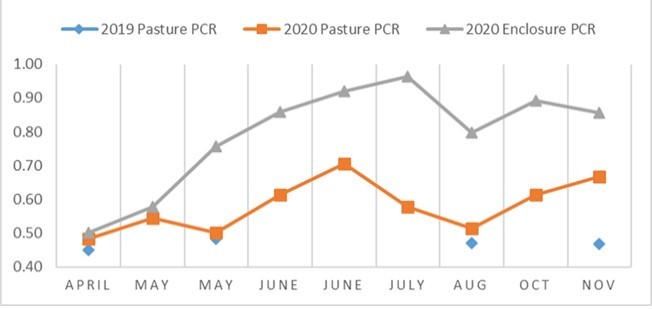
COMPARISON OF PCRs: PASTURE vs. ENCLOSURE
Figure 1. Comparison of Pasture Compaction Ratios (PCR) for study areas, 2019 and 2020.
PROJECT TAKEAWAYS:
- The pasture PCRs for 2019 and 2020 are similar which would be expected since no management changes happened.
- In April the PCRs for both the pasture and enclosure in 2019 and 2020 start out the same. The rising pasture PCR after May of 2020 indicates that the pasture's compaction resistance is improving since the PCR is moving closer to the fenceline's compaction PCR which peaked at 1.0.
- The separation of the 2020 PCRs for the pasture and the enclosure is an indication that the use of the PCR is capable of monitoring management changes. The switch to hay production only within the enclosure reduced the compaction of the soil.
- I would have expected that the reduction in compaction in the enclosure would have shown up in April of 2020 due to frost and heaving of the soil. The reduction in compaction happening after the beginning of May indicates that possibly it occurred as a result of the increase in soil temperature and biological activity causing the (aggregate) soil's air and water spaces to expand.
- I can't explain why the 2020 PCRs for pasture and enclosure deviate in August. Why did they both drop? It was suggested that the one measurement I failed to track was soil moisture. I assumed that moisture would change equally but, if the pore spaces increase as the soil is less compacted, that soil would have more water in those pores.
- The reduction in compaction in the enclosure happened within a few months. What didn't change was the makeup of the sward of bluegrass and other lower productivity species that was brought about by years of compaction in the pasture. This is why it is important to monitor compaction, changing management before the sward specie changes.
The most interesting takeaway from this study for me was how quickly the shallow compaction in the pastures dissipated. The real damage was caused in pastures where the management didn't change and the years of compaction reduced the function of the soil so that it changed the grazing sward to less productive species.
Obviously, much more study is needed to better understand the usefulness of using a ratio between two soil management areas as a monitoring technique. This project raised more questions to be addressed before a PCR can be a reliable tool. Developing a way to monitor soil compaction with a readily available tool such as the penetrometer would provide a great advantage to farmers and advisors who seek to improve the function and health of agricultural soils. To learn more about the technical details of the PCR study, see https://scnydfc.cce.cornell.edu/submission.php?id=1477&crumb=soil|7.
SIDEBAR: MANAGEMENT CHANGES TO REDUCE PASTURE COMPACTION As mentioned earlier, compaction in pasture soil is unavoidable. Some immediate suggestions for reducing compaction on your pasture and grazing lands, include:
- Graze mature swards. Benefits include deeper roots, longer rest periods, and denser bites so that the animal fills with fewer footsteps.
- Know the soil texture of your pastures. Soils high in sand and silt are more prone to compaction problems. Where these soils are, try to graze when soil is dry. A healthy texture would be equal amounts of sand, silt, and clay.
- Track your organic matter. Higher organic matter makes stronger soil aggregates or particles.
- Vary the use of paddocks where possible, e.g., start your grazing in different paddocks each spring, and allow paddocks to be harvested for hay at times.
For more tips, see "Pasture Soil Compaction: Prevention and Remediation" online and downloadable at https://projects.sare.org/wp-content/uploads/Compaction-Fact-Sheet-Final-1.pdf.
Fay Benson is the NY Soil Health Trailer Coordinator, the education coordinator for the New York Dairy Grazing Apprenticeship Program, project manager of the NY Organic Dairy Initiative, and a small dairy support specialist with the six-county Cornell University South Central New York Dairy and Field Crops Team. He can be reached at 607-391-2669, afb3@cornell.edu. GRAPHIC FILES: Pie charts comparison of undisturbed vs. compacted soil: NRCSPieChartscompaction-of-soil.png Figure 1. Comparison of Pasture Compaction Ratios (PCR) for study areas, 2019 and 2020.
- PCRComparisonGraph2Benson.jpg
The Slow and Furtive Nature of Pasture Soil Compaction (pdf; 340KB)
- View the full document with graphs and images here
Upcoming Events
North American Manure Expo
July 17 - July 18, 2024 : North American Manure Expo
Auburn, NY
Save the Date for the North American Manure Expo
Professionalism in Nutrient Management - www.manureexpo.com
Sundaes on the Farm
July 21, 2024
Spencer, NY
Learn about Tioga County Agriculture! IFree Admission! Enjoy Ice Cream, Animals and Farm Tours, Kid's Activities, Food, Live Music, and Farm Vendors.
Announcements
Farm Participants Needed for Bale Grazing Grant!
Information on the Project:- Approximately 10 acres total needed to bale graze two different bale densities
- "Core" farms will graze two winters, "Demo" farms will graze one winter.
- Payments for both "Core" farms and "Demo" farms
- Baseline soil sampling by bale grazing team
- Forage measurements in early season by bale grazing team
- Late season clipping if residual not trampled down by farm
Cornell Cow Convos - New Podcast
On-going podcast, New episodes released on the last Thursday of the month.Guest speakers, CCE Dairy Specialists.
Housed on Soundcloud Channel is CCE Dairy Educators
- Preventative healthcare for cows
- The trend of beef on dairy
- What to look forward to in the new year for dairy
- Socially grouping or pair-housing calves
Dairy Acceleration Program Funds Available
- organization of financial records/benchmarking up to $1,000
- continued business planning (for farms awarded in a previous year) up to $2,500
- business planning up to $5,000
2018 Drug Residue Prevention Manual
For more than 30 years, the U.S. dairy industry has focused educational efforts on the judicious use of antibiotics through the annual publication of a Best Practices Manual. The 2018 edition of the National Dairy FARM Program: Farmers Assuring Responsible Management? Milk and Dairy Beef Drug Residue Prevention Manual is the primary educational tool for dairy farm managers throughout the country on the judicious and responsible use of antibiotics, including avoidance of drug residues in milk and meat.The manual is a quick resource to review those antibiotics approved for dairy animals and can also be used as an educational tool and resource for farm managers as they develop on-farm best management practices necessary to avoid milk and meat residues. Visit the Manual and Form Library to download copies of this important tool!
Follow us on Facebook
The team updates our facebook page frequently - follow us to be updated on our events, see some fun videos and get local area updates!facebook.com/SCNYDairyandFieldCropsTeam
ProDairy Forage Management
Are you prepared to change your routine this spring?While spring tasks vary by farm, there are many "rites of spring," and they are often completed in a fairly rigid sequence. Depending on the farm, these often include fixing fence, spreading manure, planting new seedings, planting corn and harvesting first cutting, and are often performed in this order.
We are optimistic that the upcoming turn in weather will allow these task to be accomplished in a timely manner, but at this point it is time to ask yourself: Are you willing to change your spring routine?
In addition to adverse weather it is no secret that everyone is facing extremely tight economic times, and dealing with forage inventories of poor digestibility forages from 2017. This combination of factors makes it more critical than ever to be ready to tackle the task that will have the most impact on your business at the proper time.
Recent reference articles on dealing with tough times:
• Key Opportunities to Optimize 2018 Crop Production Efficiency
• Resources for Dealing with Spring Weather Delays
First Cutting
The number one focus should be on timely harvest of first cutting.
• Park the corn planter when a field of first cutting is ready for harvest.
o Monitoring 1st cut harvest timing
• Approach harvest by the acre, not by the field. Be ready to skip over a field that has passed its optimum harvest stage.
o Dynamic Harvest Schedules
• Strategically plan feed storage to best utilize forage inventories for the right group of animals.
o Strategic Forage Storage Planning
o When More is Better
Corn Planting
The window for planting for silage is generally wider than for grain, which is why first cutting can and should take priority over corn planting. However, in the event of extreme delays in planting corn, performance will diminish with late plantings. If corn planting progresses into late May or early June, begin to consider alternative options for those acres. Previous research from Cornell and Penn State suggest a 0.5 to 1 ton/acre per week decline in silage yield for planting after mid to late May.
Multi-Tasking
First and foremost during a time of year that can be very busy and stressful, taking every precaution to keep your team safe is critical.
The idea of fitting all of this work into a condensed time period, and still getting key tasks completed before critical deadlines can seem impossible, but year after year many find unique ways to get it all done. Consider working with neighbors, custom operators or renting equipment to accomplish these key tasks on time.
If you currently utilize custom operators, now is a good time to set up a time to meet with them and make sure you are on the same page to get tasks accomplished in the time-frame needed. Make sure that your expectations and goals are clearly defined. They will also be under stress to fit their work into a condensed period and meet their customers' expectations, so defining expectations and pre-planning how to most efficiently get the work accomplished when the custom operator arrives can go a long way to increase the chances for success.
NYSERDA Agriculture Energy Audit Program
NYSERDA offers energy audits to help eligible farms and on-farm producers identify ways to save energy and money on utility bills. Reports include recommendations for energy efficiency measures.For more information and the NYSERDA Agriculture Energy Audit Program Application click here

